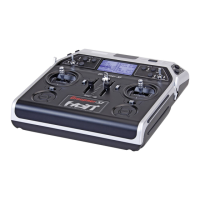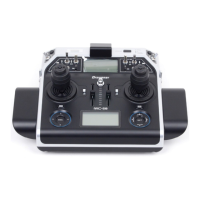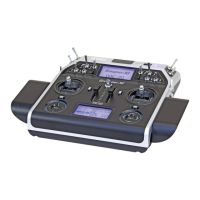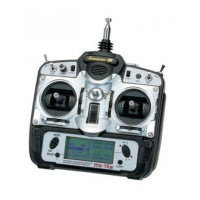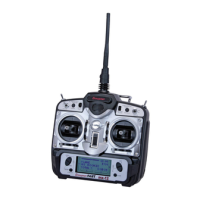137
Program description - Channel 1 curve | Helicopter models
Channel 1 curve
Control characteristics for throttle/collective pitch stick
This option is available on both transmit-
ter types.
Use the selection keys of the left or right
four-way button to scroll to the »Channel 1
curve« menu option in the Multi-function menu:
Servo adjustment
Stick mode
Switch display
Control adjust
Dual Rate / Expo
Channel 1 curve
Open this menu option with a tap on the centre SET
key of the right four-way button:
Input
Output
Point
?
0%
0%
0%
Ch1 curve
normal
Curve
off
Since the carburettor response or the effect of collec-
tive pitch is often non-linear, you can make compensa-
tory adjustments to these in this menu.
The menu therefore enables modification of the con-
trol characteristics of the motor/collective pitch stick,
regardless of whether this control function affects the
servo connected to control channel 1 directly or affects
multiple servos via various mixers.
If flight phases have been specified in the »Phase set-
tings« and »Phase assignment« menus (see pages
152 and 154) this option can be adapted on a flight-
phase basis. The given flight phase name, e. g. «nor-
mal», will be shown at the bottom left of thescreen.
The control curve can be defined by up to 6 points
(termed “reference points” below) placed anywhere
along the path of stick travel.
While the on-screen graph considerably simplifies the
process of setting and adjusting the reference points,
we recommend that you set fewer reference points to
begin with.
Please note that the curve characteristic you set here
acts as the input signal for specific mixers in the »Heli-
copter mixer« menu, page 184.
»Helicopter mixer«
Ch1
Ch1 Tail rotor
Ch1-
curve
Pitch
Thro
Pitch
stick
In the basic software set-up, 2 reference points – name-
ly the end-points at the bottom end of stick travel (“L”,
low = -100 % travel) and the top end of stick travel (“H”,
high = +100 % travel) – define a linear characteristic
curve.
First, switch to your chosen flight phase, if necessary.
Setting reference points
By moving the transmitter control (motor/collective
pitch stick), you can reposition the vertical line in the
graph between the two end-points “L” and “H”. The
current stick position is also displayed in numerical
form on the “Input” line (-100 % to +100 %). The point
at which this line crosses the curve is termed the “Out-
put”, and can be varied at the reference points within
the range -125 % to +125 %. The control signal altered
in this way will then affect all subsequent mixer and
coupling functions.
In the example above, the stick is at 0 % of control
travel and also generates an output signal of 0 %, since
the characteristic curve is linear.
Up to 4 additional reference points can be set between
the two end-points “L” and “H”, although the distance
between neighboring reference points must not be less
than approx. 25 %.
If necessary, use the left or right-hand arrow button
to move the marker frame down to the “Point” line:
Input
Output
Point
?
0%
0%
0%
Ch1 curve
normal
Curve
off
Move the stick. If a question mark can be seen in the
“Point” frame, then the next reference point can be set
with a tap on the centre SET key of the right four-way
button. Simultaneously, the “?” is replaced by a number
and the value field to the right of the reference point
number will be shown in inverse video:
1
+50%
+50%
+50%
normal
off
Input
Output
Point
Ch1 curve
Curve
The order in which you generate the (maximum) 4
reference points between the end-points “L” and “H” is
irrelevant, since the reference points are continuously
renumbered automatically from left to right as they are
entered.
Erasing reference points
To delete one of the reference points (1 to max. 4), use
the stick to move the vertical line into the vici nity of the
reference point in question. As soon as the reference
mc
16 20

